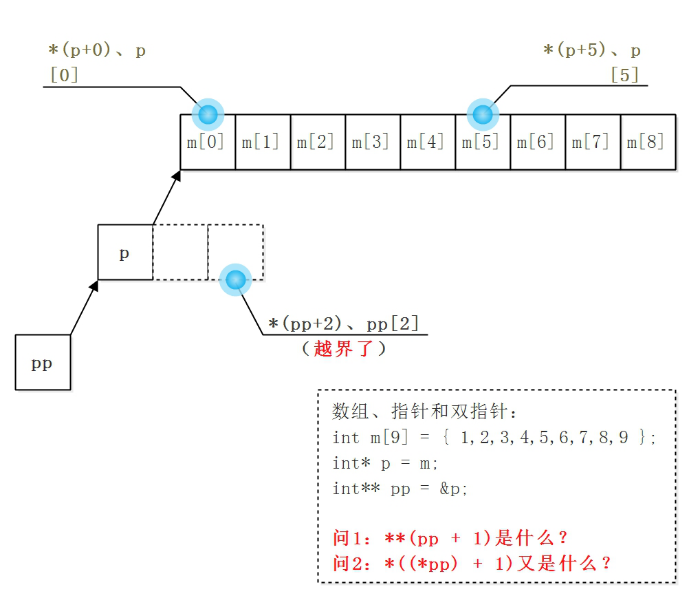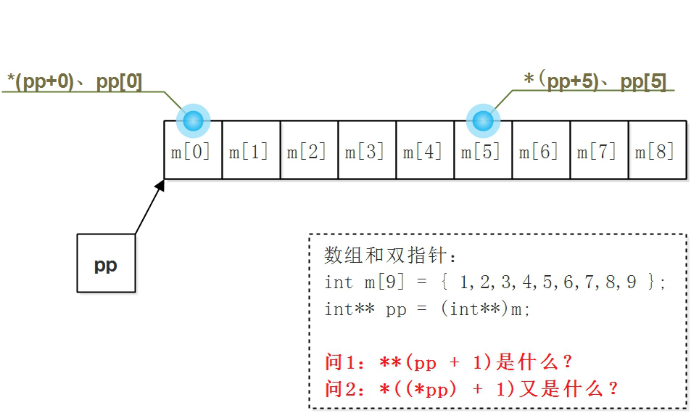table of Contents
Contents 1
1. The concept of 1
1.1. Double pointer 1
1.2. Pointer Array 1
1.3. Array Pointer 1
2. The difference between the 2
3. Compatibility 2
4. Why is the number of columns to be equal? 2
5. Initialization 3
6. Conversion 4
7. The double pointer 6
8. Diagram 8
8.1. Array, pointer and double pointer diagram 8
8.2. Array diagram and the double pointer 9
8.3. Demo Code 9
9. Related Reference 10
1. concept
1.1. Double pointer
Pointing a pointer to a pointer.
1.2. Pointer Array
Composed of an array of pointer values, i.e. data type of each element of the array values are pointer type, such as: int * p [2];
1.3. Array pointer
A point array pointers.
2. difference
|
|
|
Rows |
Number of columns |
Explanation |
| int** p1; |
Double pointer |
Is not fixed |
Is not fixed |
The number of columns and rows is uncertain, and may vary the number of columns per row. |
| int* p2[3]; |
Pointer array |
fixed |
Is not fixed |
A total of three lines, uncertain how many columns per row , and each row can vary the number of columns. |
| int (*p3)[3]; |
Array pointer |
Is not fixed |
fixed |
A total of three columns uncertain how many lines. |
3. Compatibility
| int** p1; int* p2[3]; int (*p3)[3]; int p4[2][3]; int p5[3];
// Compatibility p1 = p2; p3 = p4; p3 = & p5; // p5 number of columns and the number of columns must be the same as the p3
p1 = p2; // determine the number of both of which are not compatible with |
" The number of columns is equal to " or " columns uncertainty " Lead is compatible, as described above P3 , P4 and p5 number of three columns are the same.
4. Why is the number of columns to be equal?
Pointer support subtraction operation, such as:
| int m[3][3]; int (* pm) [3] = m + 1 ;
The second row m refers to the two-dimensional array "int m [3] [3 ];" first address in memory, such as: 0x7fff82521370. And this " 1 " refers to the size of this two-dimensional array of line, i.e. "int m [3];" size. Thus, pm values: 0x7fff82521370 + 12 is = 0x7fffd5afd94c. |
If the sequence is not equal, the subtraction operation can not be performed, it is necessary , "the number of columns equal." Assumptions:
| int** b1; int** b2 = b1 + 1; |
The above-mentioned " 1 " is actually much? This depends b1 What type is that? Here, B1 is a double pointer, i.e. a pointer to a pointer. It is essentially a pointer, thus 32 on the platform position its value is 4 , at 64 the value of its bit platform 8 .
5. Initialization
How to initialize dual-pointers, pointer arrays and array pointer? Direct look at the following code:
| #include <stdio.h>
int main () { size_t i; // 行 size_t j; // 列
int** p1; // 行数和列数,均不固定 int* p2[3]; // 行数固定为3,列数不固定 int (*p3)[3]; // 列数固定为3,行数不固定
size_t num_rows_p1 = 3; // 行数不固定,可运行时设定 p1 = new int*[num_rows_p1]; for (i=0; i<num_rows_p1; ++i) { size_t num_cols_p1 = i + 1; // 列数不固定,可运行时设定 p1[i] = new int[num_cols_p1]; for (j=0; j<num_cols_p1; ++j) p1[i][j] = i; } printf("p1[2][1]=%d\n", p1[2][1]); printf("p1[2][2]=%d\n", p1[2][2]);
const size_t num_rows_p2 = sizeof(p2)/sizeof(p2[0]); // 行数固定,不可运行时设定 for (i=0; i<num_rows_p2; ++i) { size_t num_cols_p2 = i + 1; // 列数不固定,可运行时设定 p2[i] = new int[num_cols_p2]; for (j=0; j<num_cols_p2; ++j) p2[i][j] = i; } printf("p2[2][1]=%d\n", p2[2][1]); printf("p2[2][2]=%d\n", p2[2][2]);
size_t num_rows_p3 = 5; // 行数不固定,可运行时设定 const size_t num_cols_p3 = 3; // 列数固定,不可运行时设定 p3 = new int[num_rows_p3][num_cols_p3]; for (i=0; i<num_rows_p3; ++i) { for (j=0; j<num_cols_p3; ++j) p3[i][j] = i; } printf("p3[2][1]=%d\n", p3[2][1]); printf("p3[2][2]=%d\n", p3[2][2]);
return 0; } |
6. 转化
下面这个表格,在内存中即可为“int** p1;”,也可以为“int* p2[3];”,还可以为“int (*p3)[3];”
| 1 |
2 |
3 |
| 4 |
5 |
6 |
| 7 |
8 |
9 |
如下来操作它:
| #include <stdio.h>
int main() { int m[3][3] = { {1,2,3}, {4,5,6}, {7,8,9} };
int** p1; int* p2[3]; int (*p3)[3];
p1 = new int *[3]; p1[0] = m[0]; // 列数不固定 p1[1] = m[1]; // 列数不固定 p1[2] = m[2]; // 列数不固定 printf("p1[1][2]=%d\n", p1[1][2]);
p2[0] = m[0]; // 列数不固定 p2[1] = m[1]; // 列数不固定 p2[2] = m[2]; // 列数不固定 printf("p2[1][2]=%d\n", p2[1][2]);
p3 = m; // 列数固定 printf("p3[1][2]=%d\n", p3[1][2]);
delete []p1; return 0; }
|
实际上,还可以当作一维数组,但仍然可以使用“int** p1;”、“int* p2[3];”和int (*p3)[3];”来操作,看下面的代码:
| #include <stdio.h>
int main() { int n[9] = { 1,2,3, 4,5,6, 7,8,9 };
int** p1; int* p2[3]; int (*p3)[3];
p1 = new int *[3]; p1[0] = n; p1[1] = n + 3; p1[2] = n + 6; printf("p1[1][2]=%d\n", p1[1][2]);
p2[0] = n; p2[1] = n + 3; p2[2] = n + 6; printf("p2[1][2]=%d\n", p2[1][2]);
p3 = (int (*)[3])n; // 这里也可改成:p3 = (int (*)[3])&n; printf("p3[1][2]=%d\n", p3[1][2]);
delete []p1; return 0; } |
二维数组同样也可以当一维数组使用,如:
| #include <stdio.h>
int main() { int m[3][3] = { {1,2,3}, {4,5,6}, {7,8,9} };
int *p = (int*)m; // 这里同样也可以改成:int *p = (int*)&m; printf("p[1]=%d, p[3]=%d, p[6]=%d\n", p[1], p[3], p[6]); return 0; } |
7. 双指针
int m[3]; int* p1; int** p2; int* p3[3]; int (*p4][3]);的本质是相同的,都表示一块内存,只所以有区分,是为了编译器能够按照不同的方式去访问这块内存。更通俗点说,它们都是对内存访问的协议。
从前面的例子不难看出,对于双指针“int** p1;”在使用之前,总是会先做“new int*[]”操作。如果让p1直接指向数组首地址是否可以了?
答案是不行的,假设有如下的代码:
| int m[9] = { 0x1,0x2,0x3,0x4,0x5,0x6,0x7,0x8,0x9 }; int** pp = (int**)m; |
pp[0]、pp[1]、pp[2]。。。是什么?用下面这段代码来观察:
| #include <stdio.h>
int main() { int** pp = NULL; int m[9] = { 0x1,0x2,0x3,0x4,0x5,0x6,0x7,0x8,0x9 };
pp = (int**)m; printf("pp[0]=%p, pp[1]=%p, pp[2]=%p, pp[3]=%p\n", pp[0], pp[1], pp[2], pp[3]); return 0; } |
上面这段代码中的数组元素值特意使用了16进制,以便更好的观察,它的实际输出和机器的字节序,以及位数相关,在x86输出为:
| pp[0]=0x1, pp[1]=0x2, pp[2]=0x3, pp[3]=0x4 |
在x86_64上输出为:
| pp[0]=0x200000001, pp[1]=0x400000003, pp[2]=0x600000005, pp[3]=0x800000007 |
不要被双指针“**”迷惑了,可对比下“int* p;”
| #include <stdio.h>
int main() { int* p = NULL; int** pp = NULL; int m[9] = { 0x1,0x2,0x3,0x4,0x5,0x6,0x7,0x8,0x9 };
pp = (int**)m; printf("pp[0]=%p, pp[1]=%p, pp[2]=%p, pp[3]=%p\n", pp[0], pp[1], pp[2], pp[3]);
p = m; printf("p[0]=%d, p[1]=%d, p[2]=%d, p[3]=%d\n", p[0], p[1], p[2], p[3]); return 0; } |
因为pp是双指针类型,因此它不能直接指向数组内存。
假设有一指针:int* p;,它的地址为x,则p[N]和*(p+N)都是取地址为“x+sizeof(int)”的内存数据;如果是“int** pp;”,设地址为y,则pp[N]和*(pp+N)是取地址为“y+sizeof(int*)”的内存数据。
8. 关系图
8.1. 数组、指针和双指针关系图

8.2. 数组和双指针关系图

8.3. 演示代码
| #include <stdio.h>
int main() { int m[] = { 1,2,3,4,5,6,7,8,9 }; int* p = m; int** pp = &p;
printf("sizeof(p)=%d\n", sizeof(p)); printf("sizeof(*p)=%d\n", sizeof(*p));
printf("m=%p\n", m); printf("&p=%p\n", &p); printf("*p=%lx\n", *pp); printf("**p=%d\n", **pp); // 这实际是“*((*pp)+0))”而不是“*(*(pp+0))” printf("*((*p)+0)=%d\n", *((*pp)+0)); printf("pp=%p\n", pp); printf("pp+1=%p\n", pp+1);
// 不要将“pp[0][1]”理解成:**(pp+0+1), // 这里的1实际是sizeof(*pp),也就是sizeof(int*), // 而pp是p的地址,注意不是m的地址 printf("&m[1]=%p\n", &m[1]); printf("&pp[0][1]=%p\n", &pp[0][1]); // p[0]也就是*(p+0) printf("pp[0][1]=%d\n", pp[0][1]); // p[0][1]也就是*((*(pp+0))+1)) printf("*((*(pp+0))+1)=%d\n", *((*(pp+0))+1));
printf("*((*pp)+1)=%d\n", *((*pp)+1)); // 正确,*pp是m的地址 printf("**(pp+1)=%d\n", **(pp+1)); // 越界了,因为pp的值是p的地址,不是m的地址 return 0; } |
9. 相关参考
《进一步理解指针:一维数组和二维数组转换》:
http://blog.chinaunix.net/uid-20682147-id-4967871.html
《常见指针定义解读》
http://blog.chinaunix.net/uid-20682147-id-4344901.html